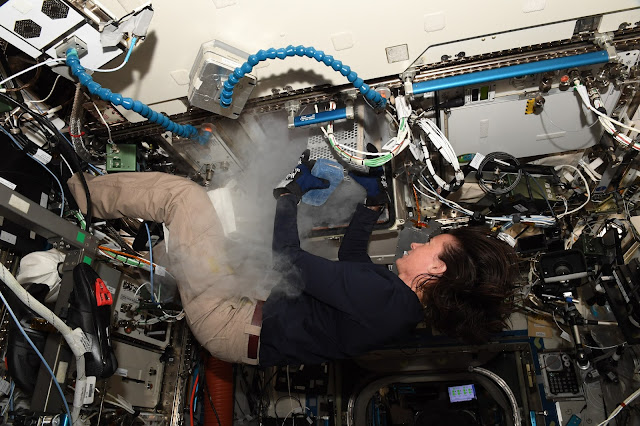Soviet Space Program - Salyut Space Station patch.
July 3, 2021
Salyut-5 was launched into orbit 45 years ago. The orbital manned station "Almaz" No. 3, created at the Central Design Bureau of Mechanical Engineering (TsKBM) under the leadership of the outstanding General Designer VN Chelomey, operated under this name. At the request of the Russian Cosmos magazine of the State Corporation Roscosmos, the veterans of the enterprise shared their memories of the hard work that accompanied the flight of the “wonderful space house” (as pilot-cosmonaut Viktor Gorbatko called the station).
Start place - Baikonur
“Since this object was intended to perform a number of applied tasks in orbit, the Ministry of Defense, as the main customer, attached great importance to its creation,” recalls Vladimir Abramovich Polyachenko, chief lead designer for the Almaz system. - The first deputy commander-in-chief of the Strategic Missile Forces, Colonel-General MG Grigoriev, was entrusted to head the State Commission for flight tests of the rocket and space system, consisting of the UR-500K (Proton-K) launch vehicle, the Almaz station and the ground complex. General designer V.N. Chelomey was appointed the technical leader of the tests.
In March 1976, the preparation of the station began at the technical position of the test site. The object, located in the laboratory building at site 92, was entangled with a network of cables, pipelines, surrounded by service decks, all kinds of consoles and stands. At the entrance to the pressurized chamber, a “chamber of purity” was organized, from where one could get inside only in a light overalls, a hat, slippers and without any foreign objects.
On June 17, 1976, after three months of preparation, autonomous and complex tests, the carrier with the station was delivered to the start. The State Commission decided to launch the launch on June 22 at 21:04 Moscow time. At the appointed time, the rocket soared into the blackness of the Kazakh night like a bright torch. After entering orbit, the orbital manned station No. 3 received the public name Salyut-5. Soon "Soyuz-21" went to her: starting on July 6, a day later he delivered the first crew to watch. Boris Volynov and Vitaly Zholobov (call sign - "Baikal") started active work."
Evpatoria in touch
The Salyut-5 flight was led by the Main Operational Group, formed at the Central Command Post in Evpatoria.
“MI Lifshits (operational call sign 19, aka 'Ivanov') was appointed as the flight director, A. F. Bogdanov (19-1, aka 'Katz'), L. N. Petrov (19-1 , aka "Katsman") and A. Ya. Petrunko (19-1, aka "Katsnelson"), - recalls the shift leader of the "Salyut-5" flight Alexei Yakovlevich Petrunko. - These callsigns and second surnames were assigned to us in the framework of countering foreign technical intelligence. We used them for open voice communication with the crew and for signing open telegrams on board.
The work went on around the clock, in three shifts ... All the parameters of the station's systems were within the specified limits, and after the transition from Soyuz-21 to Salyut-5, the crew highly appreciated the comfort in its compartments. From that moment on, Boris Volynov and Vitaly Zholobov began to carry out the flight program.
When, on the 46th day, due to an error in the daily program, Salyut-5 lost its orientation, the necessary commands left over the radio link to ensure the viability of the crew and the station as a whole. The cosmonauts received recommendations for restoring orientation and bringing the life support system into working position. In complete silence, everyone was looking forward to the next communication session. Telemetry appears earlier - and we were very happy to see that Almaz-5 is in the normal orientation."
Overcoming difficulties
On subsequent orbits, the commander and flight engineer suddenly reported some foreign odors. Neither the activation of the air purification system, nor the change in the operating modes of the life support systems changed anything. The doctors' recommendations did not help, and on August 22, a report was received about the deterioration of Vitaly Zholobov's health. The next day, the flight engineer could no longer work. We decided to terminate the flight ahead of schedule.
“On August 24, 1976, the Soyuz-21 crew returned to Earth,” recalls V. A. Polyachenko. - On September 23, at a meeting of the State Commission, Boris Volynov said: “Currently we feel good. The orbital station is mothballed and prepared to receive the second crew. Salyut-5 is a magnificent complex that should live, and we are convinced of the need for a second expedition."
On October 14, 1976, the Rodonov crew consisting of Vyacheslav Zudov and Valery Rozhdestvensky left for the station on Soyuz-23. However, the docking of the spacecraft with the Salyut-5 scheduled for the next day did not take place due to large fluctuations in the signal of the radio-technical rendezvous system. The mooring and attitude control engines of the ship operated in the self-oscillation mode, the lateral deviations relative to the station increased. The docking program was turned off, and the astronauts were returned to Earth.
On October 16, the Soyuz-23 descent vehicle splashed down into Lake Tengiz. By coincidence, 20 years before the events described, this section of the Akmola region of Kazakhstan was assigned to the area of the fall of the first stages of the R-7 ballistic missile during launches from Baikonur. Unfriendly place: cold, snowstorm, the surface of the lake is covered with a layer of sludge - a mixture of ice, snow and water. There is nothing to get the descent vehicle with the freezing crew ... And finally luck: having hooked the Soyuz-23 with a rope, the helicopter towed it to the shore. The astronauts are alive and well.
On October 26, the heroes were met by Star City. VN Chelomey at the solemn meeting thanked them for their courage and joked: "Fate does the right thing with people: they got into the water, into the bitter-salty water, and one of them is a sailor." Valery Rozhdestvensky was a military sailor-diver before the cosmonaut corps.
What was it?
“The story with unpleasant odors on board Salyut-5 showed that in space flight, non-observance of the work and rest regime has a huge impact on the psychophysical state of a person,” said Boris Izrailovich Kushner, head of the air conditioning department. - From the 10th day of the flight, Boris Volynov and Vitaly Zholobov began to receive complaints about some foreign odors in the atmosphere of the pressurized compartment. After the consultation of doctors, it was decided to interrupt the further flight: instead of 60, it lasted 49 days."
The special commission headed by the director of the Institute of Biomedical Problems, Oleg Georgievich Gazenko, included chief designers and prominent specialists in life support systems, doctors, toxic chemists, material developers, and psychologists. The commission concluded that the smell felt by the astronauts was "phantom", that is, it was born directly in the corresponding parts of the brain. It was the result of the inept actions of the ground services, who planned the daily work programs of the cosmonauts.
Based on the results of this flight, an instruction was developed that categorically forbade the astronauts to sleep and rest, and the planned duration of the work should not exceed 4–5 hours a day.
We developed special security measures: astronauts with special hand-held alarms (for all possible harmful impurities) had to enter the station wearing gas masks and measure the gas composition of the atmosphere. If at least one parameter was found to exceed the permissible concentration, the crew would return to Earth.
On February 7, 1977, the Tereki, cosmonauts Viktor Gorbatko and Yuri Glazkov, set off for the station on the Soyuz-24. The docking went brilliantly. In Evpatoria, the opening of the hatches with great excitement was awaited by the best doctors, chemists-toxicologists, specialists in life support systems, cosmonauts, and at TsKBM - the main developers of the station, headed by V.N. Chelomey.
Finally, the voice of Viktor Gorbatko was heard over the speakerphone: "Everything is fine here, you enter like a good big house!" According to the conditional code, this meant that there were no smells in the station. Measurement of the composition of the atmosphere did not reveal any impurities. The station's reputation was completely restored.
The cosmonauts stayed on board Salyut-5 for the planned 18 days, successfully completed all the tasks assigned to them, and returned to Earth on February 25. On March 30, a large meeting of the TsKBM team with the crews that visited the station took place. It was especially noted that "Gorbatko and Glazkov brought complete clarity to all technical problems, closed all misunderstandings." Having completed 6630 revolutions around the Earth, on August 8, 1977 Salyut-5 completed its 412-day flight.
Preparation and more preparation
“Without any doubt, we can say that great attention was paid to the training of the Almaz crews,” says Leonard Dmitrievich Smirichevsky, a space technology tester. - The cosmonauts were taught at various stands, at the analogue of the station, in the thematic departments. They trained on a complex simulator, studied onboard documentation, including instructions for the crew's actions in emergency situations. Documentation played an important role in the flights on the Salyut-5.
On March 30, 1977, at the meeting of the crews with the developers, many good words were spoken about the cosmonauts. I remember the moment when Yuri Glazkov presented VN Chelomey with a stopwatch and an on-board control and operation manual in response to the coinage with the station image on the background of the Earth, handed over to all crews. They were placed in one of the showcases of the Museum of History and Achievements of the enterprise. The same exposition contains envelopes and stamps with autographs of astronauts, canceled on board the station. These unique exhibits are of great interest to museum visitors. Many years later, we recall with satisfaction that tense, but interesting and friendly work, the fruits of which are still in demand today - in the development of modern spacecraft."
Russian space, Vladimir Leonardov.
ROSCOSMOS Press Release: https://www.roscosmos.ru/31747/
Images, Credits: ROSCOSMOS/Original Text in Russian mentioned, translation: Orbiter.ch Aerospace/Roland Berga.
Best regards, Orbiter.ch











































